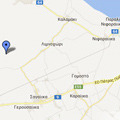Ducks - Gooses - Swans - Peakocks
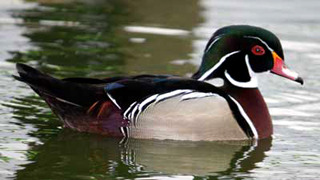 |
Carolina DuckThe Wood Duck or Carolina Duck (Aix sponsa) is a medium-sized perching duck. A typical adult is about 48 cm (19 in) in length with an average wingspan of 73 cm (29 in). The adult male has distinctive multi-colored iridescent plumage and red eyes.The female, less colorful, has a white eye-ring and a whitish throat. Their breeding habitat is wooded swamps, shallow lakes, marshes or ponds in eastern North America, the west coast of the United States and western Mexico. They usually nest in cavities in trees close to water, although they will take advantage of nesting boxes in wetland locations if available. Their personality is shy and skittish. Females typically lay between 9 and 14 eggs. They prefer nesting over water so the young have a soft landing, but will nest up to 150 yards (140 m) away from the shoreline. They overwinter in the southern United States They mainly eat berries and seeds, but also insects, making them omnivores. |
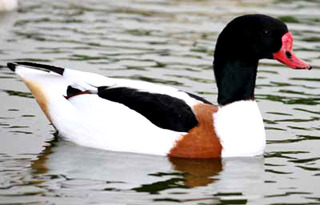 |
Common ShelduckThe Common Shelduck (Tadorna tadorna) is a widespread and common duck of the Genus Tadorna. The gooselike Common Shelduck is a striking bird with its red bill, white and chestnut body, dark green head and neck. Sexes are similar, but the female is duller. The male has a swollen red bill knob in the breeding season.This is a bird which breeds in temperate Eurasia. Most populations migrate to subtropical areas in winter, but this species is largely resident in westernmost Europe. Moulting flocks can be very large (100,000 on the Wadden Sea), since most pairs leave their partially grown young in a crèche with just one or two adults. This species is mainly associated with lakes and rivers in open country, breeding in rabbit burrows, tree holes, haystacks or similar. The diet of The Common Shelduck consists of aquatic vegetation, and small proportions of aquatic insects. |
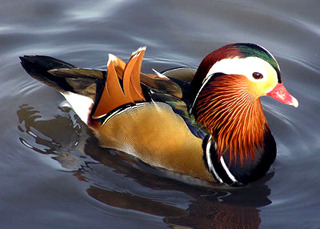 |
Mandarian DuckThe Mandarin Duck (Aix galericulata), is a medium-sized perching duck, closely related to the North American Wood Duck. It is 41–49 cm long with a 65–75 cm wingspan. The adult male is a striking bird, It has a red bill and reddish face and "whiskers". It has two orange "sails" at the back. The female is similar to female Wood Duck. The species was once widespread in eastern Asia, but large-scale exports and the destruction of its forest habitat have reduced populations in eastern Russia and in China to below 1,000 pairs in each country; Japan, however, is thought to still hold some 5,000 pairs. In the wild, Mandarin Ducks breed in densely wooded areas near shallow lakes, marshes or ponds. The Asian populations are migratory, overwintering in lowland eastern China and southern Japan. They mainly eat plants and seeds, especially beechmast. They feed mainly near dawn or dusk, perching in trees or on the ground during the day. |
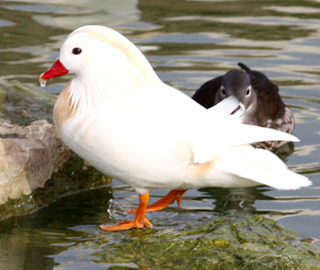 |
White Mandarin DuckThe Mandarin Duck (Aix galericulata), is a medium-sized perching duck, closely related to the North American Wood Duck. It is 41–49 cm long with a 65–75 cm wingspan. The adult male is a striking bird, It has a red bill and white body. It has two "sails" at the back. The species was once widespread in eastern Asia, but large-scale exports and the destruction of its forest habitat have reduced populations in eastern Russia and in China to below 1,000 pairs in each country; Japan, however, is thought to still hold some 5,000 pairs. In the wild, Mandarin Ducks breed in densely wooded areas near shallow lakes, marshes or ponds. The Asian populations are migratory, overwintering in lowland eastern China and southern Japan. They mainly eat plants and seeds, especially beechmast. They feed mainly near dawn or dusk, perching in trees or on the ground during the day. |
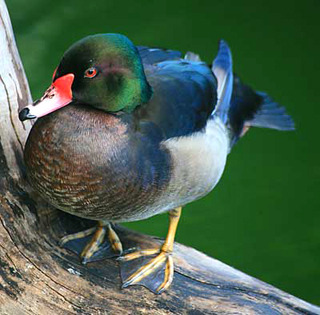 |
Rosybill DuckThe Rosybill or Rosybill Pochard (Netta peposaca) is a duck with a distinctive red bill on males and a slate-colored bill on females. Though classified as a diving duck, this pochard feeds more like a dabbling duck. The species name peposaca is derived from a Guaraní word for "showy wings", referring to the broad white stripe that is only visible with stretched out wings. The Rosybill is endemic to South America. It is found in Argentina, central Chile, Paraguay, Uruguay and southern Brazil. The population in southern Argentina migrates northward during the austral winter, reaching Brazil and southern Bolivia. It is a vagrant to the Falkland Islands. |
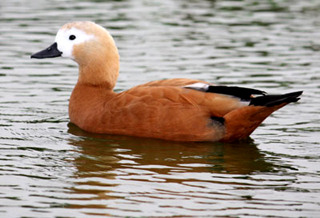 |
Ruddy ShelduckThe Ruddy Shelduck, Tadorna ferruginea, is a member of the duck, goose and swan family Anatidae. It is in the shelduck subfamily Tadorninae. In India it is known as the Brahminy Duck. There are very small resident populations of this species in north west Africa and Ethiopia, but the main breeding area of this species is from south east Europe across central Asia to southeast China. These birds are mostly migratory, wintering in southern Asia. This is a bird of open country, and it will breed on cliffs, in burrows, tree holes or crevices distant from water, laying 6-16 creamy-white eggs, incubated for 30 days. The Ruddy Shelduck is usually found in pairs or small groups and rarely forms large flocks. The Ruddy Shelduck is a distinctive species, 58–70 cm long with a 110–135 cm wingspan. It has orange-brown body plumage and a paler head. The wings are white with black flight feathers. It swims well, and in flight looks heavy, more like a goose than a duck. |
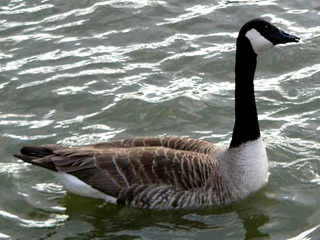 |
Canada GooseCanada Geese are found throughout North America, Central and North Europe and New Zeland.There are four subspecies (or populations); each is found in a different area of North America. Canada geese have very large wings (127 to 173 cm wingspan) that can also be used as weapons. The weight of Branta canadensis varies depending on the subspecies. A general trend in all subspecies is that they they spend summers in the northern parts of Europe and North America, especially Canada, and migrate south to areas of Europe and the United States in the winter months. They eat a variety of grasses, beans, rice, corn and a number of aquatic plants. |
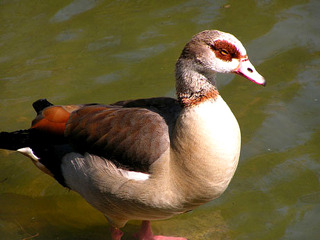 |
Egyptian GooseThe Egyptian Goose (Alopochen aegyptiacus) is a member of the duck, goose and swan family Anatidae. This 63–73 cm long species breeds widely in Africa except in deserts and dense forests, and is locally abundant. They are found mostly in the Nile Valley and south of the Sahara. It has also been introduced elsewhere; Great Britain, the Netherlands and Germany have self-sustaining feral populations. This is a largely terrestrial species, which will also perch readily on trees and buildings. It swims well, and in flight looks heavy, more like a goose than a duck, hence the English name. Egyptian Geese usually pair for life. The sexes of this striking species are identical in plumage, though the males average slightly larger Egyptian geese typically eat seeds, leaves, grasses, and plant stems. Occasionally, they will eat locusts, worms, or other small animals. |
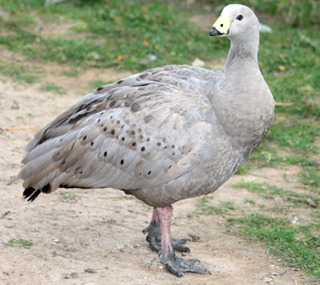 |
CareopsisThe Cape Barren Goose, Cereopsis is a large goose resident in southern Australia. These are bulky geese and their almost uniformly grey plumage, bearing rounded black spots, is unique. The tail and flight feathers are blackish and the legs are pink with black feet. The short, decurved black bill and green cere gives it a very peculiar expression. The Cape Barren Goose is 75–100 cm (30–40 in) long, weighs 3.1-6.8 kg (7-15 lbs) and has a 150–190 cm (59–75 in) wingspan; males are somewhat larger than females. This bird feeds by grazing and rarely swims. It forms small flocks. |
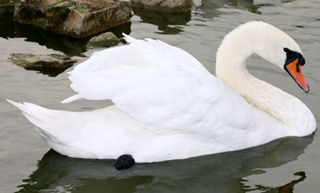 |
Mute SwanMute swans breed in the British Isles, north central Europe and north central Asia. They winter as far south as North Africa, the Near East, and to northwest India and Korea. They have been successfully introduced in North America, where they are a widespread species and permanent residents in many areas. The mute swan one of the heaviest flying birds in the world; adults can weigh over 15 kg. Males (cobs) and females (pens) are similar in appearance, although males are slightly larger and have a more prominent knob on the bill. They are large birds, measuring 144 to 158 cm. The wingspan is 2 to 2.5 meters. The plumage is white. The diet of mute swans consists of aquatic vegetation, and small proportions of aquatic insects, fish, and frogs. Mute swans do not dive, instead they plunge their head and long neck below the water's surface. |
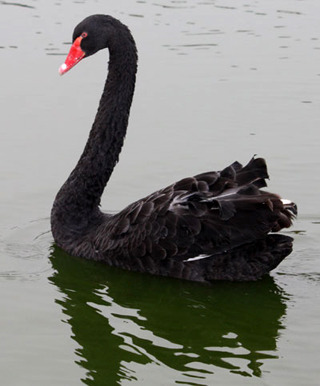 |
Black SwanCygnus atratus, commonly known as black swans, are native to Australia (including Tasmania) and have been introduced to New Zealand, Europe, and North America. Swans are the largest of all waterfowl. Black swans' closest relatives are mute swans (Cygnus olor). Cygnus atratus has the classical swan look with a long arched neck and raised eyebrows. As the name implies they are mostly black. As with many birds, there is sexual dimorphism where the male is slightly larger than the female. When they are fully grown they have a length of 110 to 140 cm and weigh between 3700 to 8750 g. The wingspan ranges between 160 to 200 cm. Cygnus atratus eats sub-aquatic foliage that it can reach under water using its long neck. It is herbivorous, eating vegetation and plants either in the water or on land in pastures or on farm land.Occasionally they also eat insects. |
 |
Indian PeacockThe Indian Peafowl, also known as the Common Peafowl or the Blue Peafowl, is one of the species of bird in the genus Pavo of the Phasianidae family. The Indian Peafowl is a resident breeder in the Indian subcontinent and has been introduced into many parts of the world and feral populations exist in many introduced regions. The species is found in dry semi-desert grasslands, scrub and deciduous forests. It forages and nests on the ground but roosts on top of trees. It eats seeds, insects, fruits, small mammals and reptiles. Females are about 86 cm (34 in) long and weigh 2.75–4 kg (6-8.8 lbs), while males average at about 2.12 m (7.3 ft) in full breeding plumage (107 cm/42 in when not) and weigh 4–6 kg (8.8-13.2 lbs). It has iridescent blue-green plumage. The upper tail coverts on its back are elongated and ornate with an eye at the end of each feather. These are the Peacock's display feathers. They lay a clutch of 4-8 eggs which take 28 days to hatch. The eggs are light brown. The male does not assist with the rearing, and is polygamous. |
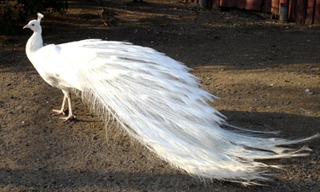 |
White Indian PeacockThe White Indian Peafowl, is one of the species of bird in the genus Pavo of the Phasianidae family. The Indian Peafowl is a resident breeder in the Indian subcontinent and has been introduced into many parts of the world and feral populations exist in many introduced regions. The species is found in dry semi-desert grasslands, scrub and deciduous forests. It forages and nests on the ground but roosts on top of trees. It eats seeds, insects, fruits, small mammals and reptiles. Females are about 86 cm (34 in) long and weigh 2.75–4 kg (6-8.8 lbs), while males average at about 2.12 m (7.3 ft) in full breeding plumage (107 cm/42 in when not) and weigh 4–6 kg (8.8-13.2 lbs). It has white plumage. The upper tail coverts on its back are elongated and ornate with an eye at the end of each feather. These are the Peacock's display feathers. They lay a clutch of 4-8 eggs which take 28 days to hatch. The eggs are light brown. The male does not assist with the rearing, and is polygamous. |



